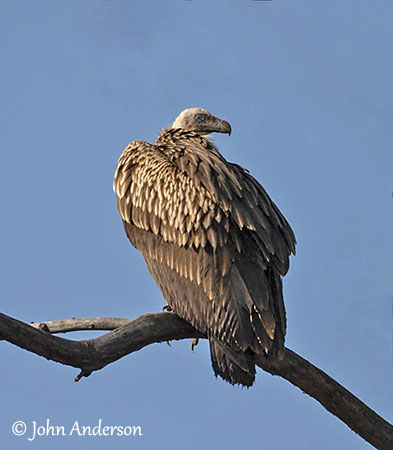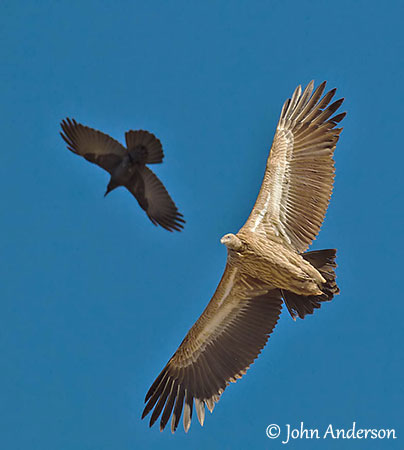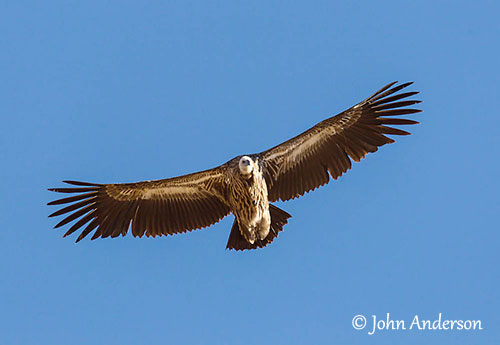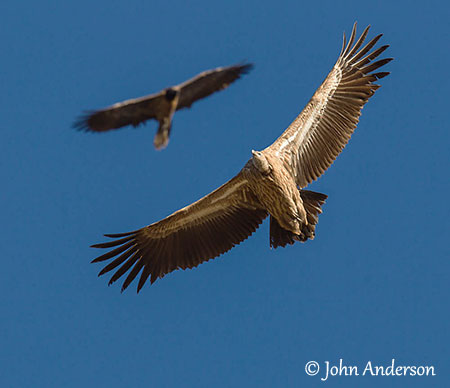
Fr: Vautour de l’Himalaya
All : Schneegeier
Esp : Buitre del Himalaya
Ital: Grifone dell'Himalaya
Nd: Sneeuwgier
Sd: Snögam
Photographer:
John Anderson
John Anderson Photo Galleries
Text by Nicole Bouglouan
Sources:
HANDBOOK OF THE BIRDS OF THE WORLD Vol 2 by Josep del Hoyo-Andrew Elliot-Jordi Sargatal - Lynx Edicions - ISBN: 8487334156
BirdLife International (BirdLife International)
The Peregrine Fund – Global Raptor Information Network
Other article: The Old World Vultures
Himalayan Griffon Vulture
Gyps himalayensis
Accipitriforme Order – Accipitridae Family
BIOMETRICS:
Length: 116-150 cm
Wingspan: 260-310 cm
Weight: 8-12 kg
DESCRIPTION:
Often mentioned in the history of the Tibetan culture, the Himalayan Griffon Vulture is a large raptor. This scavenger was in charge of feeding the body of dead people during the very cold periods of the year. The frozen soil did not allow burying the dead, and their bodies were given the vultures. This practice is still used today, but on a much smaller scale.
The Himalayan Griffon Vulture is the largest of the genus Gyps. The size may vary and some birds can be really large.
The plumage is pale overall, with whitish to creamy-white body and wing-coverts. As in other vultures Gyps, the flight feathers and the tail are dark brown.
The underparts are very pale too, with white thighs and underwings, and creamy-white body.
The base of the neck is surrounded by a whitish ruff, and the patches of bare skin on the sides of the neck base are pinkish. The neck’s skin is dark pinkish, sparsely covered in white down. The crop is brownish.
On the head, we can see short, white feathers on crown and nape. The face is bare, pale pinkish-grey.
The bill is pale bluish-grey with darker tip. The eyes are dark brown, surrounded by a pale blue-grey eye-ring. Legs and feet are pinkish-grey.
Both sexes are similar.
The juvenile is darker than adults, with the whitish underparts and upperwing-coverts finely streaked brown.
The plumage becomes paler little by little in immature bird.
VOICE: SOUNDS BY XENO-CANTO
The Himalayan Griffon Vulture utters grunts and croaks, and also hisses. Around the carcasses, it can be more vocal, giving screeches or high-pitched chatters between them.
HABITAT:
The Himalayan Griffon Vulture inhabits in mountains between 1500 and 4000 metres of elevation. In the Himalayas, this species is often down to 900 metres, but can occur up to 5000 metres in Nepal.
It may perform altitudinal movements during winter, and frequent lower areas while the young birds wander down onto plains.
RANGE:
The Himalayan Griffon Vulture is mostly resident throughout the Himalayas and also in the Central Asian mountains.
It may occasionally migrate to Northern India.
BEHAVIOUR:
The Himalayan Griffon Vulture feeds only on carrion. They gather around carcasses located by soaring and gliding over large areas.
This vulture is dominant at carcasses, except over Aegypius monachus which is almost as large as him.
They gather in small groups around the food, but the carcass is usually rapidly eaten.
As other species, these vultures fight to obtain a better place to feed. They utter some noises such as grunts and hisses during these encounters.
It also follows caravans and domestic flocks in high mountains.
The Himalayan Griffon Vulture breeds on crags in mountains, alone or in loose colonies of some pairs.
There are gregarious and roost, feed and breed together.
The pairs perform aerial displays by soaring close to each other.
This species is usually sedentary, only performing some altitudinal movements. Some young birds reach the low plains on northern India. Adults can be vagrant to Afghanistan and Turkestan.
FLIGHT:
The Himalayan Griffon Vulture often soars at great heights in the Himalayas. It is able to manage the low air pressure and the very cold temperatures of these high elevations.
REPRODUCTION:
The breeding season occurs in late winter and early spring, with the nest building recorded in late winter.
The Himalayan Griffon Vulture may be solitary nester or form small, loose colonies of about 5 – 6 pairs, usually well above the tree line.
The large stick nest is built, or repaired, by both adults on cliff face.
The female lays a singly white egg, usually in January. The incubation lasts 50 days, shared by both parents. The duration of the nesting period is unknown, but the cycle can extend for several months, seven and more.
DIET:
The Himalayan Griffon Vulture feeds exclusively on carrion.
PROTECTION / THREATS / STATUS:
The Himalayan Griffon Vulture appears to be common in most parts of the range.
This vulture occurs in the higher parts of the Himalayas. For this reason, it does not suffer from poisoning and dramatic declines as the Gyps vulture’s species in India.
The species is evaluated as Least Concern, and not currently threatened.
According to the regions, declines and increase of the populations occur regularly, making the numbers fairly stable for the moment.




With a Bearded Vulture